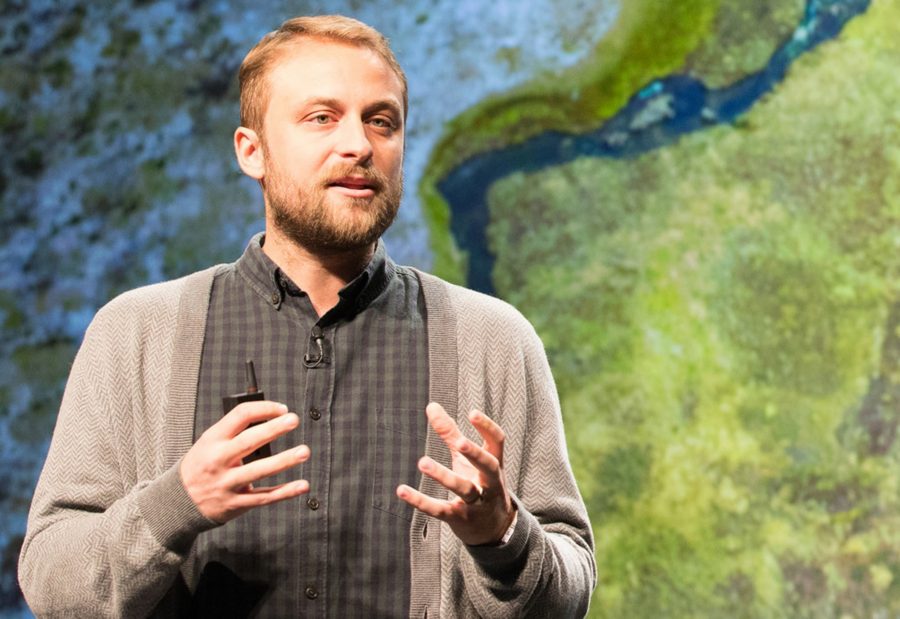So, the Earth is kind of in the middle of this crisis that’s invisible to a lot of us. We’re in the midst of the sixth mass extinction. Animal extinction rates are about a thousand times higher than what the fossil record tells us should be the baseline.
Now, mass extinctions are not anything new. If you talk to any schoolchild they can tell you about dinosaurs or the Ice Age. But the difference about this one is that it’s the first one that’s caused by a single species. And that species are humans. Part of the problem is that we’re losing the battle against wildlife crime. The illegal wildlife trade is currently the fourth most-lucrative transnational organized crime after drugs, weapon smuggling, and human trafficking. Every day a hundred elephants are killed for their tusks. We’re losing rhino and shark species at a rate that they could be gone within this generation.
So, why are we losing this battle? It’s because the methods that we use are decades-old and they’re ineffective. We depend on the military to do patrols where conservation never really ranks high on the list of things that they have to take care of. We set up small ranger or Coast Guard teams to patrol vast distances with almost no resources. It’s no surprise that we’re not winning.
But we’re also living in this amazing time. The speed of innovation has created technologies that have literally reimagined industry after industry. Technology has improved almost every tool that we use on a daily basis, and it’s time to start bringing this technology to use for good.
So, as an engineer who specializes in conservation, I work on doing exactly that. Conservation technology seeks to bring these tools into fundamentally changing how we protect this planet. So, some of my work has made use of innovations in mobile technologies, satellite data, drones, robotic vessels, and how we deal with apps and data to bring these innovations into conservation.
One of the key tools is what I like to call the Internet of Environmental Things. I’m sure everyone here’s heard of the smart home, or connected cities. Well, this is taking it one step further, those tools, and making connected ecosystems. So, by placing sensors into these vulnerable areas, we can use persistent monitoring to make sure that these places are protected in a way that was never before possible. Instead of slowly measuring the impacts of pollutants or other human activities, we can deploy these devices that watch over these areas with a fidelity and a frequency that a single person can ever do, like Botswana’s Okavango Delta. It’s one of the most critical African habitats, and one of the most amazing places in the world. The Delta was recently declared one of UNESCO’s World Heritage Site. Actually, the one thousandth World Heritage Site. It’s home to key populations of elephants, hippos, lions, and all those other charismatic megafauna that draws so many of us to Sub-Saharan Africa. It’s one of the most pristine wildernesses on this planet.
The water from the Delta starts at a catchment in Angola and flows through Namibia, and then empties out into the middle of the Kalahari desert. A delta so big that it can be seen from space. Angola came out of a twenty-six year civil war that effectively closed it off to the world. This war led to isolated communities and some of the densest minefields on earth. But since the end of that, world development has gone rampant. This includes mining, agricultural schemes, oil development. Angola is now the third-largest oil producer in Africa. All these activities have the potential to change the flood dynamics that makes the Delta possible.
The water is the lifeblood of the animals that call the Delta home. And this includes the largest remaining elephant population on the African continent. The quality of the environment out there is so important to the livelihoods of these animals that we actually call measuring the water quality “measuring the heartbeat of the Delta.”
Our sensor networks measure this environmental quality and can tell us, real-time, if something’s happening soon enough that we can actually go and do something about it. The data gets posted to the web site, and through our open API, I can pull out my cell phone and I can see what’s happening there. Accurate pH and temperature measurements. We can measure the heartbeat of the Delta from anywhere in the world.
So, next time you think about connected devices, I want you to think about the Okavango. The Internet of Environmental Things. Let’s put a Nest inside of a nest. We’re working to replicate this all over the world. And if you’re curious to learn more about it, you can join us at intotheokavango.org. Our expeditions go beyond just the Internet of Environmental Things. We share all the data we collect, including wildlife sightings, photos, audio recordings, biometrics. All the data is freely open and available to anyone through our web site. This beautiful website designed by Jer Thorp and his team at OCR.
So, over the course of the last few decades, technological progress has been in many ways kind of the enemy to environmental conservation. But we can now build tools that can help benefit every single ecosystem on this planet and finally connect us back to nature and its future. So, imagine a world where we’re no longer reactive, and we can use conservation technology to proactively become protectors of this planet. Imagine a world where we would be able to end human-caused mass extinction. Thank you.
Further Reference
This presentation at the PopTech site.
